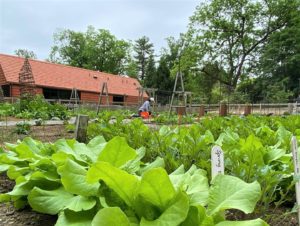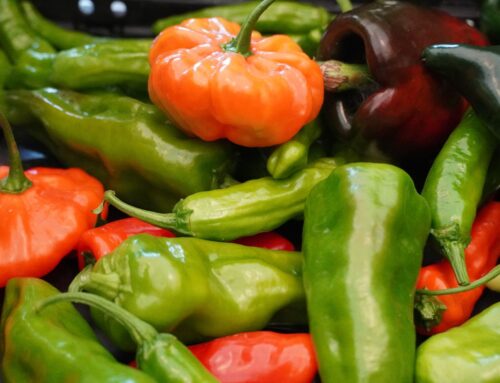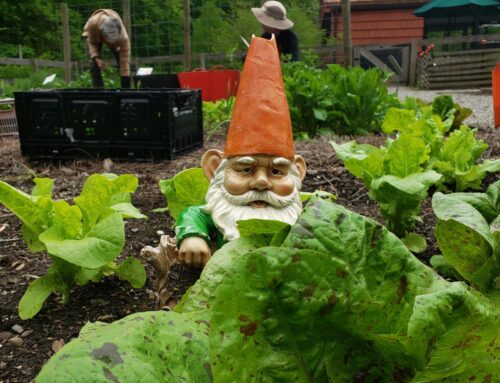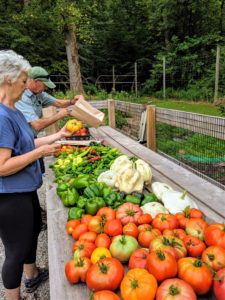
There is nothing like the feeling of harvesting the fruit of your labor. So, let’s talk about how and when to harvest the vegetables from your garden.
Harvest Daily – Everyday bring your basket to the garden and pick the vegetables and herbs that are ready to be used in cooking or enjoyed fresh. It is important to pick at the peak of flavor. For maximum flavor and best texture, most vegetables are harvested just before full maturity. Picking often encourages the plant to produce more. Remember — bigger is not always better, and in many cases it makes the fruit either woody, tough, or even bitter. Vegetables are best when harvested in the morning which will allow them to produce crisper, juicier, and sweeter vegetables.
Check Your Seed Packet – Allows you to know what to expect in terms of when your harvest is ready for picking with some variation due to weather. There are many varieties of any given vegetable which require different lengths of growing time. For example, pole beans are best picked when they are 5-6 inches long, whereas yard long beans are 15-18 inches when they are at their peak.
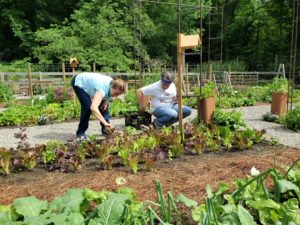
Generally, When to Pick:
Asparagus – Wait to harvest till the third year. Then begin harvesting when spears are 6-8 inches tall and as thick as your pinky finger. Snap or cut just below the soil line and before the tips begin to separate. Stop harvesting about 4-6 weeks after the initial harvest, to allow the plants to produce foliage and food for themselves. Asparagus is best stored in a glass jar with the cut ends submerged in water.
Beets – You can eat the tops when thinning out the row. They are ready anytime you see the beet shoulders protruding through the soil at 1 ½ – 2 inches in diameter. Yet, the right size is a matter of personal preference, or should I say taste! Harvest spring-planted beets before the hot weather (June). Harvest fall-planted beets before the first moderate freeze. Beets can be stored in a perforated plastic bag in the refrigerator for up to two weeks.
Broccoli – Don’t let the flower heads bloom, which can happen quickly once warm weather arrives. Harvest when the individual buds are about the size of a match head. Harvest when the main head is 3-6 inches in diameter and the flower buds are tightly closed. Do not expect your homegrown broccoli to be as big as supermarket broccoli. After the first harvest, smaller side shoots should continue to form. Broccoli can be stored in perforated plastic bags for up to a week in the refrigerator.
Brussel Sprouts – The sprouts will mature from the bottom of the plant. Begin harvesting when they are 1-1 ½ inches in diameter. Harvest by twisting off or cutting the sprout from the stem. Sprouts can be stored in a perforated plastic bags for up to three weeks in the refrigerator.
Cabbage – The cabbage head will feel solid upon being squeezed when it is time to harvest. Cabbage can be stored in the refrigerator for a month or more.
Carrots – Look at the top of the soil line to gauge the right diameter for your variety. Carrots are usually harvested ¾-1 inch in diameter. If the diameter looks good, the length should be fine too. Carrots can be left in the ground once they mature. A light frost will sweeten the carrot and improve the flavor.
Cantaloupe (Muskmelon) – Is ready for harvesting when the fruit separates easily from the stem when it is gently pulled. Also, surface netting turns beige, and the blossom end becomes soft and smells sweet. Cantaloupe can be stored in the refrigerator for up to 10 days.
Cauliflower – Harvest when the heads look full and while the curds are still smooth, and about 6-7 inches in diameter. Leave a ruffle of leaves surrounding the head when harvesting to prolong the quality. Leaving them too long will lead to brown spots and a mealy texture. Your homegrown head will be smaller than what you buy in the supermarket. Cauliflower can be stored in a perforated plastic bag for up to a week in the refrigerator.
Corn – Will be ready about three weeks after the silk forms; they will turn dry and brown. Nick a kernel with your fingernail, and if ready to harvest, they will exude a milky substance. Corn can be stored under optimal conditions (as close as possible to 32 degrees F for about five days but will lose sweetness with each day of storage).
Cucumber – Harvest young when the fruit is firm and smooth (overripe cucumbers can be very bitter), and before they start to turn yellow. Pickling types should be 2-6 inches in length, while slicing and burpless should be picked when 6-10 inches long. Harvest by cutting stem with a sharp knife or pruners. Cucumbers can be stored in the refrigerator for about a week.
Eggplant – Has the best flavor when slightly immature. The fruit should be firm and shiny. The fruit is ripe when the side of the fruit is pressed slightly with a thumbnail, and the indentation remains. Cut, rather than pulling, from the plant. Eggplant will store in the refrigerator for a week.
Garlic – Is ready when the leaves begin to yellow and the tops brown and fall over in early summer. Dig up the bulbs, don’t pull them up, brush off the dirt, do not wash, and allow the bulbs to dry until the outer skin is papery, approximately 2-3 weeks before storing.
Kale and Collards – The leaves can be picked throughout the season. The leaves should be deep green with a firm, sturdy texture. The flavor is better in cool weather and is improved after the first frost. Entire plants can be cut when very young, half-grown or full-grown. Collards and kale can be stored much like asparagus, in a glass container with the cut ends submerged in water.
Leeks – Start harvesting when about one inch in diameter.
Lettuce (Head) – Harvest once the heads feel full and firm with a gentle squeeze. Hot weather will cause it to bolt or go to seed, rather than filling out. Head lettuce will store for two weeks when stored in the coolest area of the refrigerator.
Lettuce (Leaf) – Pick the outer leaves once they have reached 4 inches in height. Allow the inner leaves to grow. Leaf lettuce can be harvested in this fashion for most of the summer. Leaf, bib, and romaine will store as long as four weeks if the leaves are dry when bagged. You can place lettuce in a salad spinner and add paper towels to soak up extra moisture.
Onions – Dig up once the tops have fallen over. Allow the onions to dry in the sun before storing.
Peas – Pea pods should look and feel full. Peas are sweeter if harvested before fully plump. You will need to taste them to determine if they are sweet enough. Store unshelled peas in a plastic bag in the refrigerator for about a week.
Peppers – Can be picked when they are green, or you can allow them to ripen further till they are red or orange. Cut the stems, rather than breaking the branches. Store peppers in the refrigerator for two to three weeks.
Potatoes – “New potatoes” can be harvested when the tops of the plants start to flower. Carefully dig at the outer edge of the row. For full-size potatoes, wait until the tops of the potato plants dry and turn brown. Start digging from the outside perimeter and move in cautiously to avoid slicing into potatoes.
Pumpkins – Once the pumpkins have turned the expected color and the vines are starting to decline, check to make sure the skin has hardened enough by poking it with a fingernail. You should not be able to poke through the skin. You don’t want to pick your pumpkins too soon, because they will stop turning orange once they’re cut, but don’t leave them out if a hard frost is expected.
Radishes – Mature quickly and are ready to harvest when the shoulders of the bulbs pop out of the soil line. If left too long, they will become tough and eventually go to seed.
Swiss Chard – As with leaf lettuce and kale, cut or break the outer leaves about 1 inch above the soil line, allowing the center to continue growing in the cut-and-come-again fashion. Baby leaves can be used for salads. Harvesting can continue till flowering. Swiss Chard can be stored in a plastic bag in the refrigerator for up to two weeks.
Spinach – Harvest individual leaves when the plant is about 6 inches tall. Spinach goes to seed quickly. As the plants mature, harvest by cutting stems at the soil line before you see a flower stalk beginning to shoot up. Spinach can be stored in the refrigerator in a plastic bag for up to two weeks.
Squash (Summer: Zucchini, Yellow or Patty Pan) – Pick young and often; they grow extremely fast. The skins should be tender enough to poke a fingernail through.
Squash (Winter: Butternut, Acorn) – Color is a good indicator, so when it turns the color it is supposed to be, cut it from the vine. Do not let winter squash be exposed to frost.
Tomatoes – Harvest them when they are fully colored and slightly soft to the touch. They should give off that distinctive tomato scent and pull easily from the vine when given a gentle twist. You can also harvest a tomato slightly before it is fully ripe and store stem side down on a windowsill to ripen fully. Tomatoes should be stored at room temperature.
Watermelon – The white spot on the bottom of the melon should change to deep yellow when ripe. Some people can tell when it is ripe by thumping it with their finger and then hearing a hollow sound when ripe, which is a developed skill. Watermelon can be stored at room temperature for a week to three weeks in the refrigerator.
